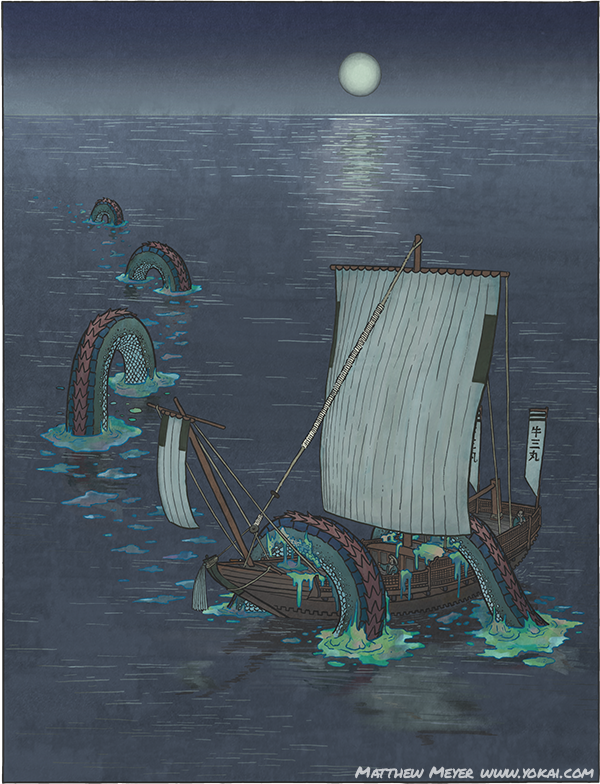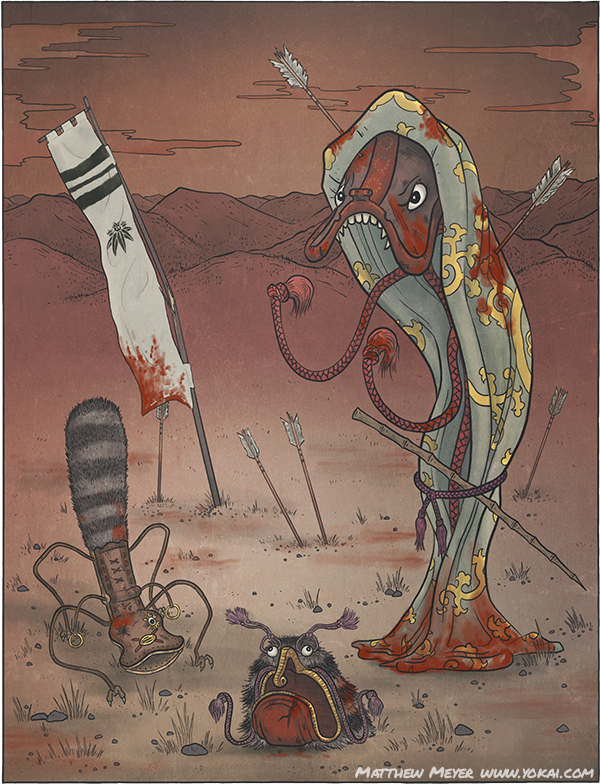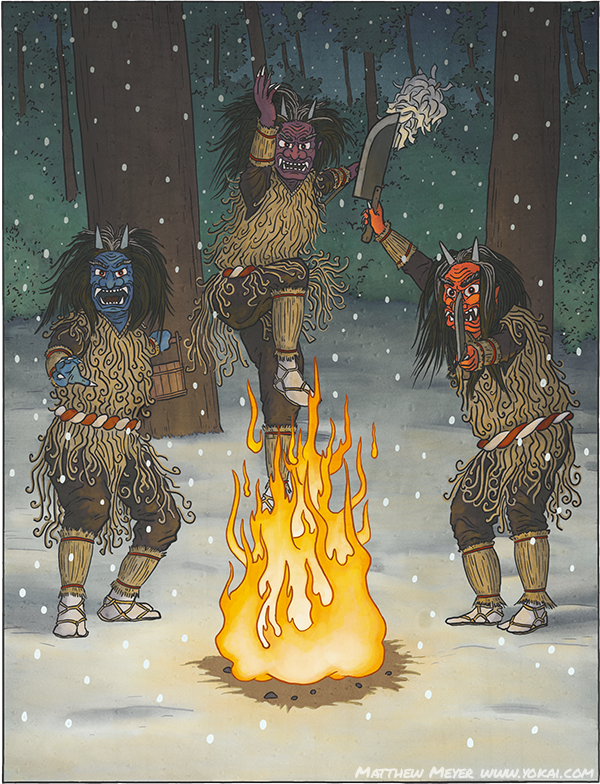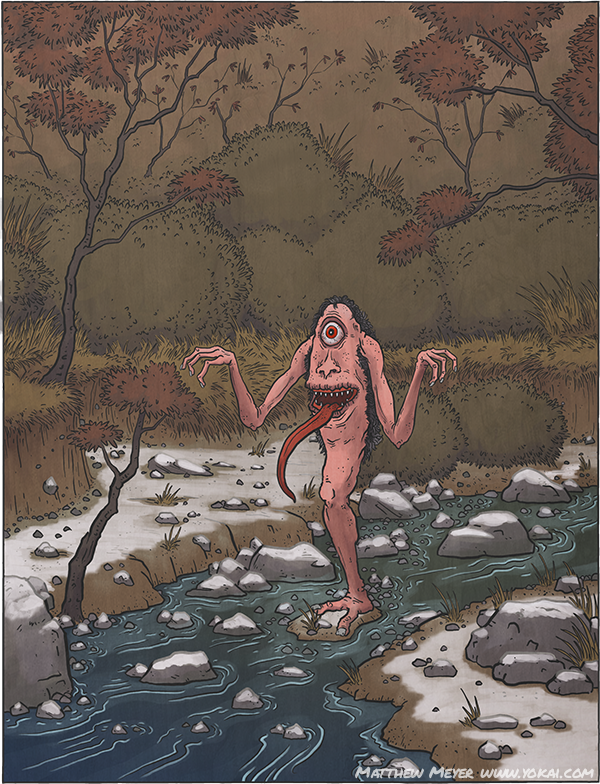Today’s yokai is really fun because not only is it imposing and awesome, but it is one of the rare creatures with a longer legend behind it, instead of simply a few sentences in one of Toriyama Sekien’s books. But first, an interesting question: what exactly is a yokai?
I ask this because invariably, when a famous creature like Yamata no Orochi, or kirin, or tatsu, etc. are brought up, someone is going to say, “I thought XX was a bakemono, not a yokai!” or “Wow, XX is a yokai? I had no idea!”
It’s a strange question, because how do we really classify made-up creatures? Where is the line between yokai and yurei, or yokai and kaiju, or even yokai and monster? And even though it seems strange to pick nits over imaginary creatures, it is something that we have been doing for a long time—at least as long as we have been classifying real creatures! Even back when Toriyama Sekien was writing his books, he was developing something like a Linnaean taxonomy for them.
Generally, if you ask any number of yokai-ologists (is that a thing??) to define a yokai, you will get as many definitions as you have people. Most of the time, the similarities are just too vague to truly iron out. One story might seem to draw a clear distinction between certain characteristics of a particular yokai, but then another story might blow those distinctions to pieces.
For example, some people might argue that a kirin is a kami, not a yokai… but then in some places, kappa and hyosube (to name a few) are worshiped as kami and even have their own shrines. Does that mean kappa are kami as well? Many ghosts are also worshiped as kami, such as the famous Tenjin-sama, who is the god-version of the yurei Sugawara no Michizane. So is he not a yurei? Some might say that yurei are the spirits of people, but then are onibi ghosts or yokai or something else? The vagaries are endless, and it becomes impossible to pin down a truly authoritative definition.
And then, of course there are the similar terms bakemono, mamono, mononoke, and so on… where does it end?
So what most foklorists do is use the term “yokai” as a very vague descriptor. Is a kirin a kami? Yes, and it is also a yokai. Same goes for yurei. Sugawara no Michizane is a yurei, a kami, a yokai, and a person. Some people, like Mizuki Shigeru for instance, will even go so far as to say that Dracula, the Wolf Man, even hobgoblins and bugbears are kinds of yokai!
Personally, I prefer to put a few limits on my use of the word. I don’t include Western monsters in my definition of yokai. I also tend to exclude Asian monsters that don’t have a strong Japanese character to them. For example, many many yokai were imported to Japan from China. Plenty were even just copied out of Chinese bestiaries. I would consider them to be yokai; however, I would not consider their native Chinese versions to be yokai. There is a similar term in Chinese—yaoguai (which is pretty much the exact same word)—which might decribe them perfectly well, but I try to keep a strictly-Japanese definition.
I also don’t include modern pop-culture creatures as yokai. Pikachu, Usapyon, Godzilla and other kaiju, and so on do not fit my definition of yokai. This is a much more arbitrary decision, as it is hard to draw a line. After all, I consider kuchisake onna, hanako-san, and teketeke to be yokai, even though those are very modern urban legends—younger than Godzilla, even. But they are missing something… a “folk” quality to them. Even though plenty of yokai were created by Edo period illustrators for commercial purposes, something feels different about those. There is a quality to them that is different from Pikachu and Godzilla. Perhaps one day, in a few decades, kaiju and pokemon will join the ranks of yokai… but not for a while in my book anyway.
I also tend to exclude a lot of kami. Animal kami I feel fit the description of yokai very easily. Plenty of people consider kitsune, for example, to be kami. But they are also yokai… However, gods like Amaterasu or Izanagi certainly don’t feel like yokai. There is a more official, ceremonial, or even mythical aura to them as opposed to a vengeful ghost-god like Sugawara no Michizane. Gods that were part of the early mythology of Japan don’t have the same essence as the later additions. This area is much harder to draw the line at… The gods that tend to be “yokai-like” are the gods that have a strong folk lore to them. For example, yokai that were enshrined in a local village, or folk heroes that were deified like Taira no Masakado.
So what does that leave us? My broadest definition of yokai would be “a creature or phenomenon from Japanese folklore.” Not very descriptive… But to clarify it a bit further, it can include gods, ghosts, unexplained occurrences, and monsters. It can also include foreign imports, as long as they pick up a uniquely Japanese identity. Gods/kami can be yokai, but usually are not. Legendary beasts straddle the line between kami and yokai, but I think they can be safely included in both.
Yamata no Orochi is a good character to bring up because he straddles many of these definitions. He is a mythological beast. Some even call him a god, and he interacts with gods in the creation myths of Japan. Yet he is also truly monstrous, and a lot of folk lore surrounds him. (He doesn’t really fall into the yurei sphere at all, so we’ll have that be.) I think that we can safely say that he is all of the above; legendary beast, monster, god… and definitely a yokai.
Of course, there is no “right” answer to this question. I take some comfort in the fact that most of the professors and yokai-ologists I have heard tend to agree with my own definition, more or less. But I have no real argument with those who disagree either. At most, it can become a fun dinner-table discussion. If you are having dinner with the right people, of course!
Click on the image below to read about Yamata no Orochi. Or, get my book The Hour of Meeting Evil Spirits and keep Yamata no Orochi on your bookshelf!








